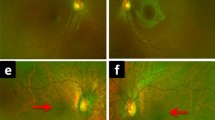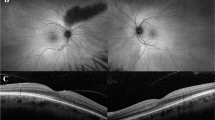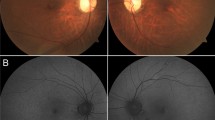Abstract
Purpose
The enhanced S-cone syndrome (ESCS) is a rare hereditary retinal degeneration that has enhanced short wavelength-sensitive cone (S-cone) functions. The longitudinal clinical course of this disease has been rarely reported, and the genetic aspects of ESCS have not been well investigated in the Japanese population. In this report, we present our clinical and genetic findings for 2 patients with ESCS.
Patients and methods
The patients were 2 unrelated Japanese men. Standard ophthalmic examinations and mutation screening for the NR2E3 gene were performed.
Results
Patient 1 was a 36-year-old man, and his clinical findings were typical of ESCS. His decimal best-corrected visual acuity (BCVA) was 1.0 OD and 0.5 OS after removal of cataracts. Genetic investigations revealed a homozygous truncation frameshift, the p.I307LfsX33 mutation. Patient 2 was an 11-year-old boy when he was first examined by us. His clinical findings were typical of ESCS except for uveitis in the left eye. His decimal BCVA at the age of 39 years was maintained at 1.5 in each eye, although the retinal degeneration and visual field impairments had progressed during the follow-up period. The genetic investigations revealed homozygous mutations of p.R104Q in the NR2E3 gene.
Conclusions
The frameshift mutation, p.I307LfsX33, in the NR2E3 gene is a new causative mutation for ESCS. The clinical observations for patient 2 are the longest ever reported. The retinal degeneration caused by this mutation is slowly progressive, and these patients maintained good vision with maintenance of the foveal structure until their late thirties.






Similar content being viewed by others
References
Online Mendelian inheritance in man (OMIM). In: National Center for Biotechnology Information (NCBI), U.S. National Library of Medicine. 2016. http://www.ncbi.nlm.nih.gov/omim. Accessed 29 Apr 2016.
Marmor MF, Jacobson SG, Foerster MH, Kellner U, Weleber RG. Diagnostic clinical findings of a new syndrome with night blindness, maculopathy, and enhanced S cone sensitivity. Am J Ophthalmol. 1990;110:124–34.
Jacobson SG, Marmor MF, Kemp CM, Knighton RW. SWS (blue) cone hypersensitivity in a newly identified retinal degeneration. Invest Ophthalmol Vis Sci. 1990;31:827–38.
Kellner U, Zrenner E, Sadowski B, Foerster MH. Enhanced S cone sensitivity syndrome: long-term follow-up, electrophysiological and psychophysical findings. Clin Vis Sci. 1993;8:425–34.
Pachydaki SI, Bhatnagar PA, Barbazetto IA, Klaver CC, Freund BK, Yannuzzi LA. Long-term follow-up in enhanced S-cone syndrome. Retin Cases Brief Rep. 2009;3:118–20.
Kuniyoshi K, Hayashi T, Sakuramoto H, Nakao A, Sato T, Utsumi T, et al. Novel mutations in enhanced S-cone syndrome. Ophthalmology. 2013;120:431–431e.6.
Nakamura Y, Hayashi T, Kozaki K, Kubo A, Omoto S, Watanabe A, et al. Enhanced S-cone syndrome in a Japanese family with a nonsense NR2E3 mutation (Q350X). Acta Ophthalmol Scand. 2004;82:616–22.
Usui T, Ichibe M, Tanimoto N, Ueki S, Takagi M, Hasegawa S, et al. Ocular fundus images by scanning laser ophthalmoscopy in a patient with enhanced S-cone syndrome. Retina. 2004;24:946–52.
Hayashi T, Gekka T, Goto-Omoto S, Takeuchi T, Kubo A, Kitahara K. Novel NR2E3 mutations (R104Q, R334G) associated with a mild form of enhanced S-cone syndrome demonstrate compound heterozygosity. Ophthalmology. 2005;112:2115–22.
Audo I, Michaelides M, Robson AG, Hawlina M, Vaclavik V, Sandbach JM, et al. Phenotypic variation in enhanced S-cone syndrome. Invest Ophthalmol Vis Sci. 2008;49:2082–93.
Pachydaki SI, Klaver CC, Barbazetto IA, Roy MS, Gouras P, Allikmets R, et al. Phenotypic features of patients with NR2E3 mutations. Arch Ophthalmol. 2009;127:71–5.
Bandah D, Merin S, Ashhab M, Banin E, Sharon D. The spectrum of retinal diseases caused by NR2E3 mutations in Israeli and Palestinian patients. Arch Ophthalmol. 2009;127:297–302.
Genead MA, Fishman GA, McAnany JJ. Efficacy of topical dorzolamide for treatment of cystic macular lesions in a patient with enhanced S-cone syndrome. Doc Ophthalmol. 2010;121:231–40.
Rocha-Sousa A, Hayashi T, Gomes NL, Penas S, Brandão E, Rocha P, et al. A novel mutation (Cys83Tyr) in the second zinc finger of NR2E3 in enhanced S-cone syndrome. Graefes Arch Clin Exp Ophthalmol. 2011;249:201–8.
Cima I, Brecelj J, Sustar M, Coppieters F, Leroy BP, De Baere E, et al. Enhanced S-cone syndrome with preserved macular structure and severely depressed retinal function. Doc Ophthalmol. 2012;125:161–8.
Hull S, Arno G, Sergouniotis PI, Tiffin P, Borman AD, Chandra A, et al. Clinical and molecular characterization of enhanced S-cone syndrome in children. JAMA Ophthalmol. 2014;132:1341–9.
Hayashi T, Gekka T, Tsuneoka H. Spontaneous resolution of large macular retinoschisis in enhanced S-cone syndrome. Ophthalmic Surg Lasers Imaging Retina. 2016;47:187–90.
Vaclavik V, Chakarova C, Bhattacharya SS, Robson AG, Holder GE, Bird AC, et al. Bilateral giant macular schisis in a patient with enhanced S-cone syndrome from a family showing pseudo-dominant inheritance. Br J Ophthalmol. 2008;92:299–300.
Nakamura M, Hotta Y, Piao CH, Kondo M, Terasaki H, Miyake Y. Enhanced S-cone syndrome with subfoveal neovascularization. Am J Ophthalmol. 2002;133:575–7.
Lam BL, Goldberg JL, Hartley KL, Stone EM, Liu M. Atypical mild enhanced S-cone syndrome with novel compound heterozygosity of the NR2E3 gene. Am J Ophthalmol. 2007;144:157–9.
Hayashi T, Kitahara K. Optical coherence tomography in enhanced S-cone syndrome: large macular retinoschisis with disorganized retinal lamination. Eur J Ophthalmol. 2005;15:643–6.
Yzer S, Barbazetto I, Allikmets R, van Schooneveld MJ, Bergen A, Tsang SH, et al. Expanded clinical spectrum of enhanced S-cone syndrome. JAMA Ophthalmol. 2013;131:1324–30.
Arevalo JF, Kozak I. Enhanced S-cone syndrome and macular hole. JAMA Ophthalmol. 2015;133:e15108.
Greenstein VC, Zaidi Q, Hood DC, Spehar B, Cideciyan AV, Jacobson SG. The enhanced S cone syndrome: an analysis of receptoral and post-receptoral changes. Vis Res. 1996;36:3711–22.
Marmor MF, Tan F, Sutter EE, Bearse MA Jr. Topography of cone electrophysiology in the enhanced S cone syndrome. Invest Ophthalmol Vis Sci. 1999;40:1866–73.
Yamamoto S, Hayashi M, Takeuchi S. Electroretinograms and visual evoked potentials elicited by spectral stimuli in a patient with enhanced S-cone syndrome. Jpn J Ophthalmol. 1999;43:433–7.
Udar N, Small K, Chalukya M, Silva-Garcia R, Marmor M. Developmental or degenerative-NR2E3 gene mutations in two patients with enhanced S cone syndrome. Mol Vis. 2011;17:519–25.
McCulloch DL, Marmor MF, Brigell MG, Hamilton R, Holder GE, Tzekov R, et al. ISCEV standard for full-field clinical electroretinography (2015 update). Doc Ophthalmol. 2015;130:1–12.
Milam AH, Rose L, Cideciyan AV, Barakat MR, Tang WX, Gupta N, et al. The nuclear receptor NR2E3 plays a role in human retinal photoreceptor differentiation and degeneration. Proc Natl Acad Sci USA. 2002;99:473–8.
Ripamonti C, Aboshiha J, Henning GB, Sergouniotis PI, Michaelides M, Moore AT, et al. Vision in observers with enhanced S-cone syndrome: an excess of S-cones but connected mainly to conventional S-cone pathways. Invest Ophthalmol Vis Sci. 2014;55:963–76.
Haider NB, Jacobson SG, Cideciyan AV, Swiderski R, Streb LM, Searby C, et al. Mutation of a nuclear receptor gene, NR2E3, causes enhanced S cone syndrome, a disorder of retinal cell fate. Nat Genet. 2000;24:127–31.
Kobayashi M, Takezawa S, Hara K, Yu RT, Umesono Y, Agata K, et al. Identification of a photoreceptor cell-specific nuclear receptor. Proc Natl Acad Sci USA. 1999;96:4814–9.
Peng GH, Ahmad O, Ahmad F, Liu J, Chen S. The photoreceptor-specific nuclear receptor Nr2e3 interacts with Crx and exerts opposing effects on the transcription of rod versus cone genes. Hum Mol Genet. 2005;14:747–64.
Haider NB, Demarco P, Nystuen AM, Huang X, Smith RS, McCall MA, et al. The transcription factor Nr2e3 functions in retinal progenitors to suppress cone cell generation. Vis Neurosci. 2006;23:917–29.
Jacobson SG, Sumaroka A, Aleman TS, Cideciyan AV, Schwartz SB, Roman AJ, et al. Nuclear receptor NR2E3 gene mutations distort human retinal laminar architecture and cause an unusual degeneration. Hum Mol Genet. 2004;13:1893–902.
Sharon D, Sandberg MA, Caruso RC, Berson EL, Dryja TP. Shared mutations in NR2E3 in enhanced S-cone syndrome, Goldmann-Favre syndrome, and many cases of clumped pigmentary retinal degeneration. Arch Ophthalmol. 2003;121:1316–23.
Gerber S, Rozet JM, Takezawa S, dos Santos LC, Lopes L, Gribouval O, et al. The photoreceptor cell-specific nuclear receptor gene (PNR) accounts for retinitis pigmentosa in the crypto-Jews from Portugal (Marranos), survivors from the Spanish Inquisition. Hum Genet. 2000;107:276–84.
Coppieters F, Leroy BP, Beysen D, Hellemans J, De Bosscher K, Haegeman G, et al. Recurrent mutation in the first zinc finger of the orphan nuclear receptor NR2E3 causes autosomal dominant retinitis pigmentosa. Am J Hum Genet. 2007;81:147–57.
Fishman GA, Jampol LM, Goldberg MF. Diagnostic features of the Favre-Goldmann syndrome. Br J Ophthalmol. 1976;60:345–53.
Jacobson SG, Román AJ, Román MI, Gass JDM, Parker JA. Relatively enhanced S cone function in the Goldmann-Favre syndrome. Am J Ophthalmol. 1991;111:446–53.
Bonilha VL, Fishman GA, Rayborn ME, Hollyfield JG. Retinal pathology of a patient with Goldmann-Favre syndrome. Ophthalmic Genet. 2009;30:172–80.
Kuniyoshi K, Uno N, Irifune M, Shimomura Y. Electroretinography of short-wavelength-sensitive cones with a LED built-in electrode and its normal values. Doc Ophthalmol. 2003;106:311–8.
Mizunoya S, Kuniyoshi K, Arai M, Tahara K, Hirose T. Electroretinogram contact lens electrode with tri-color light-emitting diode. Acta Ophthalmol Scand. 2001;79:497–500.
PolyPhen (polymorphism phenotyping). 2012. http://genetics.bwh.harvard.edu/pph/data/. Accessed 29 Apr 2016.
PolyPhen-2 (polymorphism phenotyping v2). 2016. http://genetics.bwh.harvard.edu/pph2/. Accessed 29 Apr 2016.
SIFT. 2011. http://sift.jcvi.org/. Accessed 29 Apr 2016.
Align GVGD. In: International Agency for Research on Cancer, World Health Organization. 2016. http://agvgd.iarc.fr/. Accessed 29 Apr 2016.
LOVD v3.0 (Leiden Open Variation Database). 2016. http://www.lovd.nl/3.0/home. Accessed 29 Apr 2016.
National Center for Biotechnology Information (NCBI). 2016. http://www.ncbi.nlm.nih.gov/. Accessed 29 Apr 2016.
Human Gene Mutation Database (HGMD). 2016. https://www.qiagenbioinformatics.com/products/human-gene-mutation-database/. Accessed 29 Apr 2016.
Human Genetic Variation Database (HGVD). 2016. http://www.genome.med.kyoto-u.ac.jp/SnpDB/. Accessed 29 Apr 2016.
Acknowledgments
We thank the patients and their families for their kind participation in this study; Professor Kunihiko Shiraki and Doctor Kumiko Hirayama of Department of Ophthalmology and Visual Science, Graduate School of Medicine, Osaka City University, for providing precise clinical data on the parents of patient 1; Professor Emeritus Duco I. Hamasaki of the Bascom Palmer Eye Institute of the University of Miami, for his critical discussion and final manuscript editing. This research was supported in part by research grants from the Ministry of Education, Culture, Sports, Science and Technology, Japan [Grant-in-Aid for Scientific Research (C) 2546738] and the Japan Agency for Medical Research and Development (Practical Research Project for Rare/Intractable Diseases, 15ek0109072h0002 and 26310601).
Author information
Authors and Affiliations
Corresponding author
Ethics declarations
Conflicts of interest
K. Kuniyoshi, None; T. Hayashi, None; H. Sakuramoto, None; H. Mishima, None; H. Tsuneoka, None; K. Tsunoda, None; T. Iwata, None; Y. Shimomura, None.
About this article
Cite this article
Kuniyoshi, K., Hayashi, T., Sakuramoto, H. et al. New truncation mutation of the NR2E3 gene in a Japanese patient with enhanced S-cone syndrome. Jpn J Ophthalmol 60, 476–485 (2016). https://doi.org/10.1007/s10384-016-0470-0
Received:
Accepted:
Published:
Issue Date:
DOI: https://doi.org/10.1007/s10384-016-0470-0




